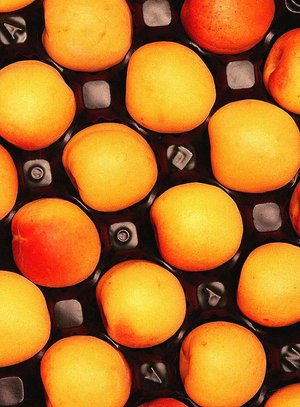Apricot
|
|
| Apricot | ||||||||||||||
|---|---|---|---|---|---|---|---|---|---|---|---|---|---|---|
| Missing image Apricots.jpg Apricot | ||||||||||||||
| Scientific classification | ||||||||||||||
| ||||||||||||||
| Binomial name | ||||||||||||||
| Prunus armeniaca |
The apricot is a fruit bearing tree of the species Prunus armeniaca, in the same subgenus as the plum (Prunophora), and also the name of the fruit it produces. The apricot tree is small to medium sized and produces a spreading, dense canopy; its leaves are shaped somewhat like a heart, with pointed tips, and about 8 cm (1/3 inch) wide. Its flowers are white to pinkish in color. The fruit appears similar to a peach or nectarine, with a color ranging from yellow to orange and possibly a red cast; its surface is smooth and nearly hairless. Apricots are stone fruits (drupes), and have only one seed each, often called a pit.
| Contents |
Origin
The apricot originated in northeastern China near the Russian border, not in Armenia as the scientific name suggests. It did arrive in Armenia after moving through central Asia, which took about 3,000 years. The Romans brought it into Europe through Anatolia about 70 BC, with the name "a praecox," significant of its earliness[1] (http://www.gutenberg.org/dirs/1/1/3/6/11369/11369.txt). While English settlers brought the apricot to the English colonies in the New World, most of modern American production of apricots comes from the seedlings carried to the west coast by Spanish Missionaries. Turkey provides 85 percent of the world's dried apricot and apricot kernels today.
Medicinal and non-food uses
Cyanogenic glycosides (found in most stone fruit seeds, bark, and leaves) are found in high concentration in apricot seeds. The drug laetrile, a purported treatment for cancer, is extracted from apricot seeds. As early as AD 502 apricot seeds were used to treat tumors and in the 17th century apricot oil was used in England against tumors and ulcers. Seeds of the apricot grown in central Asia and around the Mediterranean are so sweet that they may be substituted for almonds. Oil expressed from these varieties has been used as cooking oil.
Apricots are most often grafted on root stock. A cutting of an existing apricot plant provides the fruit characteristics such as flavor, size, et cetera, but the root stock provides the growth and disease fighting characteristics of the plant.
Cultural aspects
In Europe, apricots were long considered an aphrodisiac, and is used in this context in William Shakespeare's A Midsummer Night's Dream and John Webster's The Duchess of Malfi. Dreaming of apricots, in English folklore, is said to be good luck, though the Chinese believe the fruit is a symbol of cowardice.

